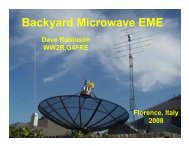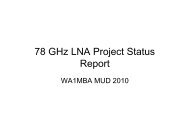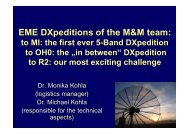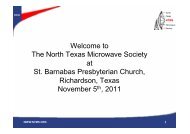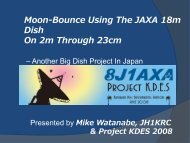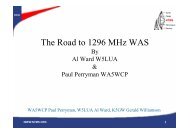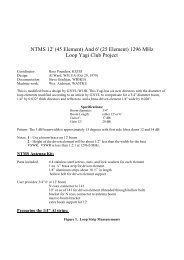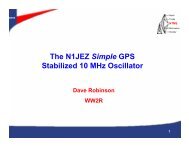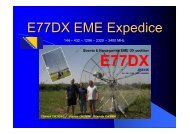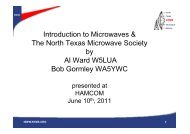You also want an ePaper? Increase the reach of your titles
YUMPU automatically turns print PDFs into web optimized ePapers that Google loves.
“ECHOES OF APOLLO”<br />
A 40 th Year Anniversary <strong>of</strong> the <strong>Apollo</strong> 11<br />
Moon Landing<br />
Presented to Clovis Amateur Radio<br />
Club<br />
Dave Smith W6TE<br />
August 7, 2009
9 Years later…
3 Days later…
Present Time --- <strong>Echoes</strong> <strong>of</strong> <strong>Apollo</strong><br />
Celebrating <strong>Apollo</strong> Missions on the 40th<br />
Anniversary <strong>of</strong> Man's Moon Landing, July<br />
20th 1969. You are invited to the world's<br />
biggest space party....ever!
THE PITCH<br />
Initial meeting with SRI’s management<br />
Dr. Michael Cousins,<br />
Director <strong>of</strong> the<br />
Stanford Dish<br />
discussing some <strong>of</strong><br />
the finer points <strong>of</strong> the<br />
dish with Dave Smith,<br />
W6TE. (March 2009)
Major Obstacles To Overcome<br />
• Obtain a feed horn which can produce circular<br />
polarization for 1296 MHz. (23 cm)<br />
• Preamplifier must be mounted at the feed.<br />
– Protection <strong>of</strong> the preamp through sequencing.<br />
• Developing as much Tx power as possible at<br />
the feed
OM2AA, Rasto’s, Septum Feed<br />
Chek Replubic
Inside feed showing feed probes.
SHAKEDOWN TEST – May 26 th , 2009
Dr. Wayne Overbeck, N6NB, and Pat Barthelow, AA6EG.
Tripod arm<br />
being winched<br />
into place by<br />
Dr. Mike<br />
Cousins and<br />
Lance Ginner,<br />
K6GSJ.
Jim Klassen, N6JMK, listening to echoes
New York Times reporter, Ashlee Vance, and
EoA June 26-27, 2009
Two weeks later <strong>K6MYC</strong> joins the<br />
group with QRO power!
6 X 2C39 water cooled, cavity amplifier<br />
capable <strong>of</strong> 1 KW on 1296 MHz!
<strong>Echoes</strong> <strong>of</strong> <strong>Apollo</strong> – Stanford<br />
June 25-27th
1-5/8” Patch Panel…
<strong>K6MYC</strong>, K6GSJ, W6TE and N6JMK
BBQ at the Ginner residence…
After a hard days work no self respecting<br />
Moonbouncer would be without a glass <strong>of</strong> wine<br />
and a bottle <strong>of</strong> Excedrin..
The morning <strong>of</strong> June 26 th “<strong>Echoes</strong> <strong>of</strong> <strong>Apollo</strong>” begins.
QSO Between Astronaut Bill Anders<br />
This historic QSO<br />
was completed<br />
on 23 CM<br />
between stations<br />
K5SO and W6SRI<br />
(Stanford SRI<br />
dish). Lisa Sonne<br />
is a reporter for<br />
Wired Magazine.<br />
and Reporter Lisa Sonne
This report from Christop Joos from<br />
More than 300 Visitors,<br />
many Families, Swiss<br />
Television, News<br />
Journalists, joined our<br />
outstanding Party. 45<br />
Children took this<br />
chance to send a short<br />
Message to the Moon.<br />
And a few did a great job<br />
and learned very quickly<br />
how we communicate.<br />
Switzerland
Report from Mt. Pleasant<br />
• Completed a 10 mw moonbounce QSO, this<br />
maybe a record for the smallest power ever<br />
used for a moonbounce contact on 1296 MHz,
CQ-VHF Magazine
NEW YORK TIMES<br />
• Mar 22, 2009 - World Moon Bounce / EME<br />
Day Gathering Momentum.<br />
• June 26, 2009 - A Ham Radio Weekend for<br />
Talking to the Moon<br />
Jim Klassen, N6JMK, Lance<br />
Genner, K6GSJ, and Dr.<br />
Michael Cousins pictured in<br />
NYT article.
San Francisco Chronicle<br />
June 27, 2009<br />
• Ham radio operators shoot for the moon<br />
– Scores <strong>of</strong> Bay Area ham radio operators will aim<br />
high this weekend to see who can bounce their<br />
signals <strong>of</strong>f the moon in an effort to talk to friends<br />
far away. It won't be an easy feat; it has never<br />
been tried before, said Doug Teter, a computer<br />
cable specialist who is coordinating the effort led<br />
by the Palo Alto Amateur Radio Alliance, but<br />
alliance members will have a go at it, competing<br />
to see who can be the first to talk to a friend on<br />
the other side <strong>of</strong> the United States or Canada.
San Jose Mercury News<br />
June 27, 2009<br />
• Stanford dish part <strong>of</strong> weekend festival <strong>of</strong> moon talking<br />
• Dogs bay at it. Lovers swoon under it. And some people like to bounce<br />
their voices <strong>of</strong>f it.<br />
• The first two are easy, but sending a voice signal 239,200 miles to the<br />
moon and back is not quite as simple.<br />
• Today, amateur radio buffs or "hams," as they call themselves, will hold a<br />
global bounce-fest, using as many giant parabolic antenna radio<br />
telescopes as they can borrow around the world.<br />
• One <strong>of</strong> them is located on a hill overlooking Stanford University's campus<br />
and will serve as the command center for the weekend's event.<br />
• Not that one needs an excuse to hold a moon-bounce, but this one is<br />
being held as a kind <strong>of</strong> advance celebration <strong>of</strong> the 40th anniversary next<br />
month <strong>of</strong> the <strong>Apollo</strong> 11 mission
Reuters News Service<br />
Top 10 News stories <strong>of</strong> June 27 th ! Moon-lovers<br />
remember <strong>Apollo</strong> with radio chit-chat.
Reuters News Service<br />
June 27, 2009<br />
• Moon-lovers remember <strong>Apollo</strong> with radio chit-chat<br />
• SYDNEY (Reuters) - Radio hams and amateur astronomers around the<br />
world spent the weekend bouncing radio conversations <strong>of</strong>f the Moon to<br />
one another in commemoration <strong>of</strong> the <strong>Apollo</strong> 11 landings 40 years ago,<br />
organizers in Australia said Sunday.<br />
• Although they had some clear and extensive conversations, they had to be<br />
patient. It takes around 2.5 seconds for a radio signal to reach the Moon<br />
and bounce back to another part <strong>of</strong> the Earth, so it took around five<br />
seconds to get a reply.<br />
• Initiated a few months ago by science buffs in Australia and the United<br />
States, 'Moonbounce' was just winding up on Sunday Australian time after<br />
a 24-hour special event that organizers hope will become annual.<br />
• It brought together hundreds <strong>of</strong> amateur radio hams around the world,<br />
event co-founder Robert Brand told Reuters, some armed with their own<br />
radio dishes.
Wired Magazine<br />
• June 3 rd . One Giant Bounce for Mankind<br />
• July 6 th . - Ham Operators Shoot the Moon<br />
Pat Barthelow, AA6EG,<br />
standing on SRI’s<br />
Stanford dish’s feedpod.
SRI Stanford EOA Team<br />
– Dr. Michael Cousins<br />
– Mike Staal, <strong>K6MYC</strong><br />
– Dr. Wayne Overbeck, N6NB<br />
– Jim “Chickenwire” Klassen, N6JMK<br />
– Lance Genner, K6GSJ<br />
– Pat Barthelow, AA6EG<br />
– Dr. Dave Leeson, W6NL (Stanford Univ.)<br />
– Larry Bettencourt, WA6LUT<br />
– Stephen Muther, WF6R (SRI)<br />
– Brian Kl<strong>of</strong>as, KF6ZEO (SRI)<br />
– Dave Smith, W6TE



